The WD Red family of NAS-tuned hard drives is a perfect example of the ways mature technology like the hard drive can continue to be specialized for new applications. Today WD has announced new additions to the Red lineup; two 2.5-inch drives, which will be the first drives of that form factor on the market that are optimized for use with small network attached storage. If WD is correct in their market assessment, there will be a growing demand for small form factor NAS devices, and developing Red HDDs in the smaller form factor will give the company a head start.
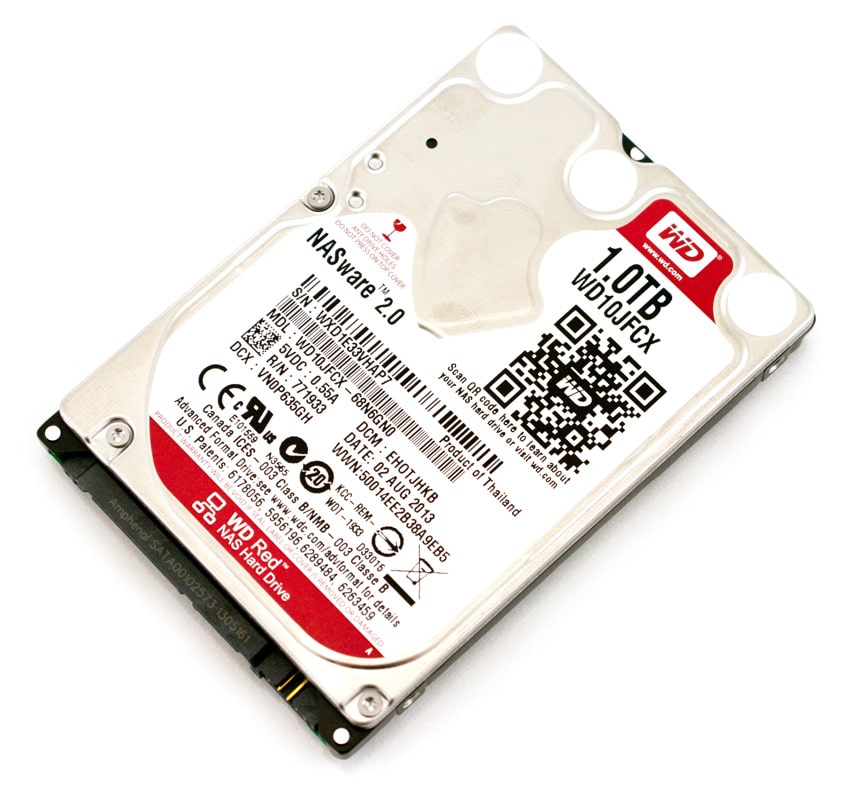
The move to 2.5″ NAS drives is interesting in that when we look at mainstream NAS vendors, there aren’t exactly a pile of small form factor NASs around. In fact, the only one to hit our lab in the last many years is the Synology DS411slim which if you ask Synology, they’ll tell you the diminutive NAS was designed more as a proof of concept and a gadget, than a specific-use type of NAS. The idea of having smaller NAS units on desks and in more conspicuous locations than server rooms and telco closets may mean the market is primed for growth. There are also some industrial and military NAS designs that rely on SFF drives, but those don’t exactly make up a large slice of the market. WD is an enabler then with the 2.5″ NAS hard drive, punching out a product that seeks to call Synology, QNAP, Netgear and others to the table to design and manufacture more small NAS systems. With the 1TB top capacity Red, the idea isn’t crazy; 4 or 5TB of data in a NAS that’s hardly larger than the drives themselves might be a compelling offering for the home and small office.
The 2.5″ WD Red comes in 1TB (WD10JFCX) and 750GB (WD7500BFCX) capacities. WD’s Red lineup is designed for small NAS systems with up to five drive bays. Our review units include five of the 1TB Red drives.
WD Red 1TB HDD Specifications
- Model number: WD10JFCX
- Interface: SATA 6 Gb/s
- Formatted capacity: 1 TB
- Form factor: 2.5-inch
- Advanced Format (AF): Yes
- RoHS compliant: Yes
- Data transfer rate (max)
- Interface speed: 6 Gb/s
- Internal transfer rate: 144 MB/s
- Cache (MB): 16
- Rotational speed (RPM): IntelliPower
- Load/unload cycles: 600,000
- Non-recoverable read errors per bits read: <1 in 1014
- MTBF (hours): 1,000,000
- Limited warranty (years): 3
- 5VDC ±10% (A, peak): 1.00
- Average power requirements (W)
- Read/Write: 1.4
- Idle: 0.6
- Standby/Sleep: 0.2
- Temperature (°C):
- Operating: 0 to 60
- Non-operating: -40 to 65
- Shock (Gs)
- Operating (2 ms, read/write): 400
- Operating (2 ms, read): –
- Non-operating (2 ms): 1000
- Acoustics (dBA)
- Idle: 24
- Seek (average): 25
- Height (in./mm): 0.374/9.5
- Length (in./mm): 3.94/100.2
- Width (in./mm, ± .01 in.): 2.75/69.85
- Weight (lb./kg, ± 10%): 0.25/0.115
Design and Build
The 1TB WD Red is offered in a slim 2.5″ form-factor with a 9.5mm z-height. This size allows it to fit in almost all mounting conditions with space concerns and matches the size of other 1TB models on the market. WD follows their standard design scheme with a single sticker on the top cover giving users information such as model, capacity, data of manufacturer and other details.
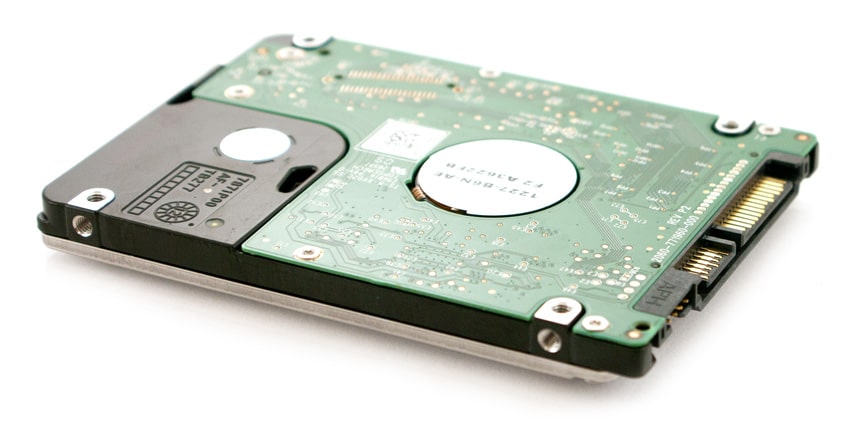
Looking inside the 1TB 2.5″ WD Red, we find a Marvell 88i9446 controller as well as 16MB of cache provided by a Winbond DRAM package. This setup is similar to the one found on the 9.5mm 1TB Scorpio Blue, although with a different controller.
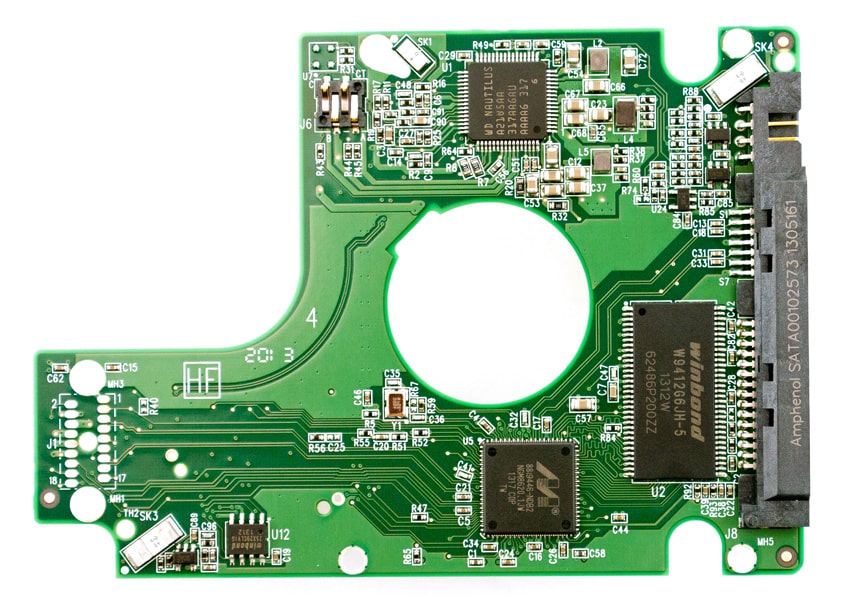
Testing Background and Comparables
24×7 operation in small NAS systems entails engineering for performance characteristics different from other drives. Because there are no other comparable drives with both a 2.5-inch form factor and tuning for NAS devices, we will compare the 1TB Red with two other recent 2.5-inch drives: the HGST Travelstar 7K1000 and WD’s Blue Slim 1TB to get an idea how Red distinguishes itself from other drives with the same form factor. Each drive is benchmarked on its own, and then benchmarked in sets of five drives in the Synology DS1513+, Synology’s latest high end 5-bay NAS unit.
Benchmarking comparables for this review:
- HGST Travelstar 7K1000 (1TB, 7,200 class)
- WD’s Blue Slim 1TB (1TB, 5,400 class)
All enterprise HDDs are benchmarked on our enterprise testing platform based on a Lenovo ThinkServer RD240. The ThinkServer RD240 is configured with:
- 2 x Intel Xeon X5650 (2.66GHz, 12MB Cache)
- Windows Server 2008 Standard Edition R2 SP1 64-Bit and CentOS 6.2 64-Bit
- Intel 5500+ ICH10R Chipset
- Memory – 8GB (2 x 4GB) 1333Mhz DDR3 Registered RDIMMs
- LSI 9211 SAS/SATA 6.0Gb/s HBA
Enterprise Synthetic Workload Analysis
Our synthetic enterprise storage benchmark process begins with an analysis of the way the drive performs during a thorough preconditioning phase. Each of the comparable drives are secure erased using the vendor’s tools, preconditioned into steady state with the same workload the device will be tested with under a heavy load of 16 threads with an outstanding queue of 16 per thread, and then tested in set intervals in multiple thread/queue depth profiles to show performance under light and heavy usage.
Preconditioning and Primary Steady State Tests:
- Throughput (Read+Write IOPS Aggregate)
- Average Latency (Read+Write Latency Averaged Together)
- Max Latency (Peak Read or Write Latency)
- Latency Standard Deviation (Read+Write Standard Deviation Averaged Together)
Our Enterprise Synthetic Workload Analysis includes two profiles based on real-world tasks. These profiles have been developed to make it easier to compare to our past benchmarks as well as widely-published values such as max 4k read and write speed and 8k 70/30, which is commonly used for enterprise drives.
- 4k
- 100% Read or 100% Write
- 100% 4k
- 128k (Sequential)
- 100% Read or 100% Write
- 100% 128k
Performance and Synthetic Benchmarks
Synthetic benchmarks show the performance of the drive in an uncached “worst case” scenario. In the 4k FIO synthetic read/write test, the WD Red 1TB had similar performance characteristics to its cousin, the WD Blue Slim. Both outperformed HGST’s Travelstar 7K1000.
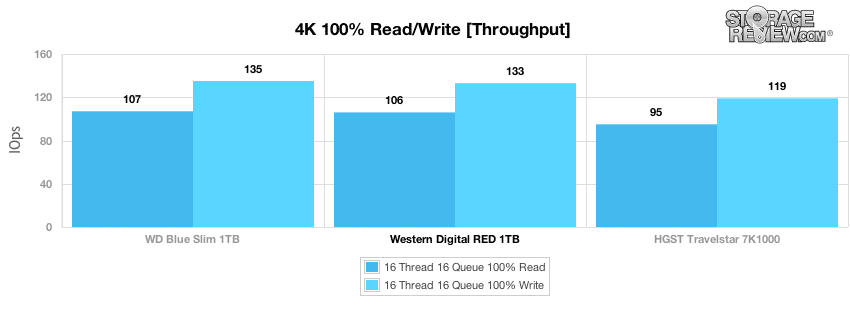
Looking at 4k average latency results, Red again performs comparably — although a little slower — than the WD Blue Slim and outperforms the Travelstar 7K1000.
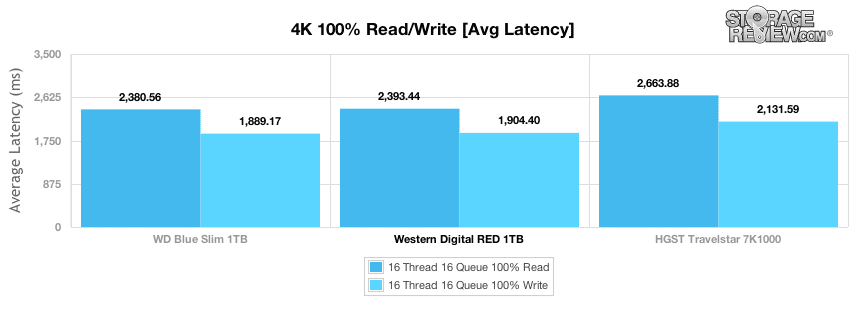
This pattern holds true in the 4k maximum latency benchmark, although the WD Red 1TB slips farther behind the WD Blue Slim in maximum read latency.
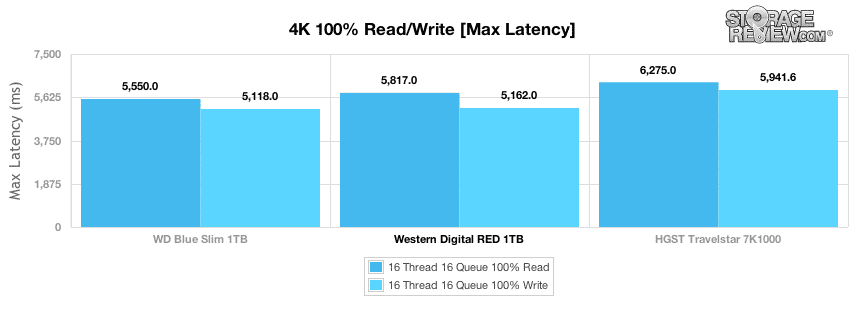
Charting the standard deviation underscores the overall finding of the 4k synthetic benchmarks: the WD Red 1TB is able to maintain performance that is close to the WD Blue Slim, with both of WD’s offerings coming out on top of the HGST Travelstar 7K1000.
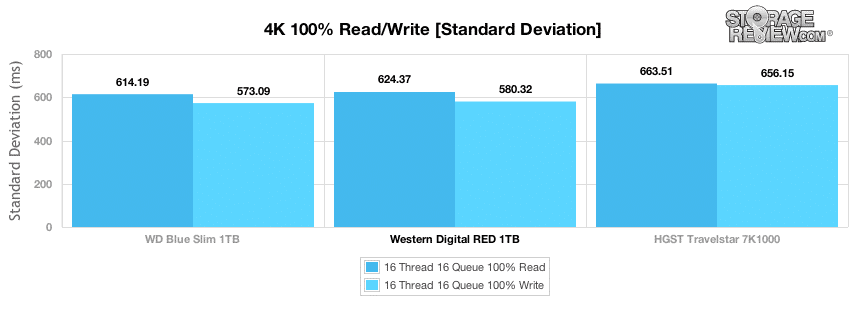
The 128k large block sequential benchmark shows the highest sequential transfer speed for a platter drive with 100% write and 100% read activity. WD’s 2.5-inch drives lose their dominance here, as the Travelstar 7K1000 performs similarly to the WD Slim in the read test and betters both WD drives in the write test.
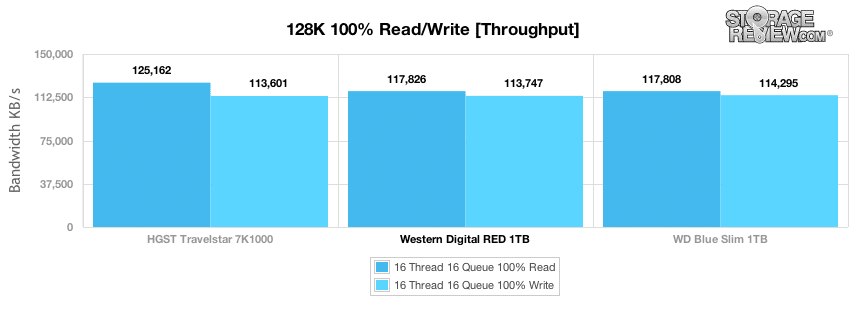
Synology DiskStation DS1513+ Performance
In the second half of this review, we show the performance of both the new 2.5″ WD Red 1TB and the 3.5″ WD Red 4TB HDD. WD supplied StorageReview with 5 samples of both new HDDs, which we configured in RAID5 in our Synology DiskStation DS1513+. Leveraging SMB/CIFS shares we show how well a 50GB test sample size performed on each storage array we created.
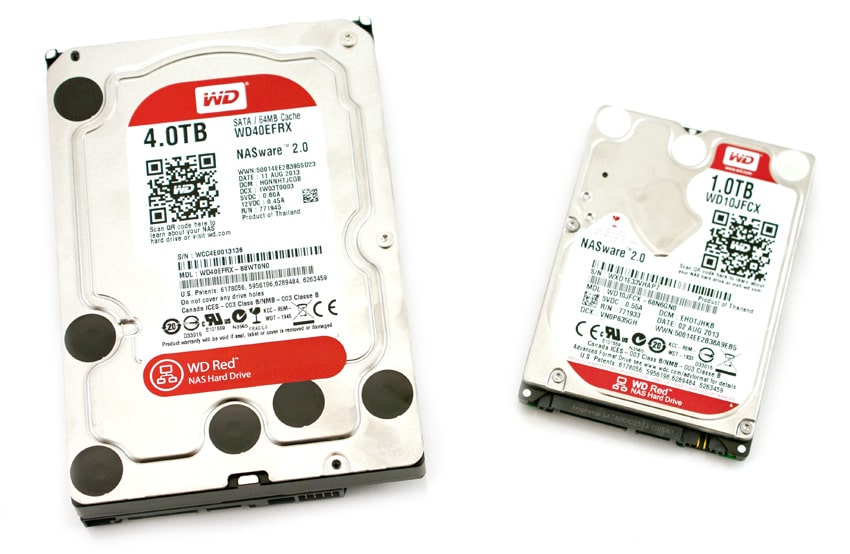
In our first test measuring 4K random performance, the 3.5″ WD Red 4TB and 2.5″ WD Red 1TB both offered a step up in performance compared to the original 3TB WD Red, although still came up slightly behind the Seagate 4TB NAS HDD. The new 1TB WD Red offered storage read performance, although weaker write performance in the group.
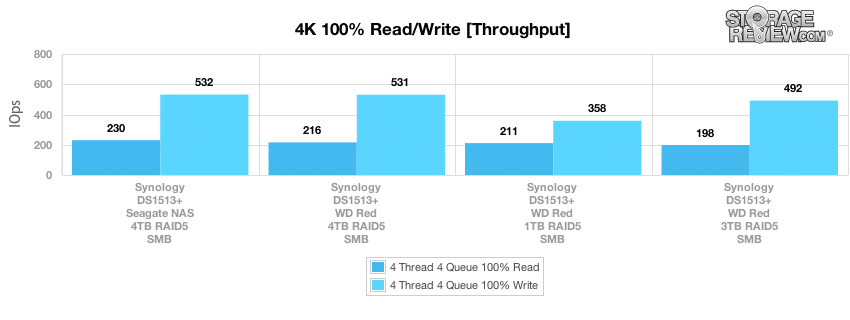
Average latency from the 4TB and 1TB WD Red ranked middle of the pack, showing improvements over the first-generation 3TB WD Red.
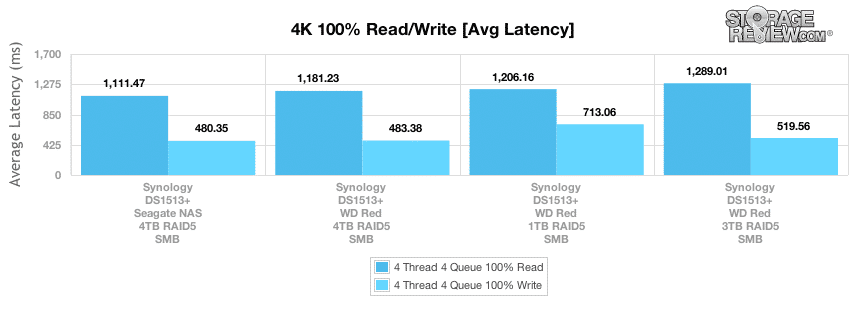
Comparing max latency, the 1TB and 4TB WD Red both came in at the front when it came to peak read latency, although the 2.5″ 1TB Red came in at the bottom of the pack with its higher write latency.
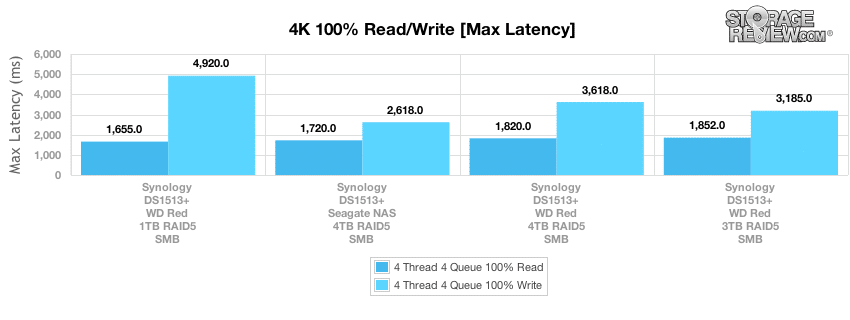
Looking at latency consistency, the 1TB WD Red came in at the top of the pack when it came to read standard deviation, but slipped to the back in respects to its write performance.
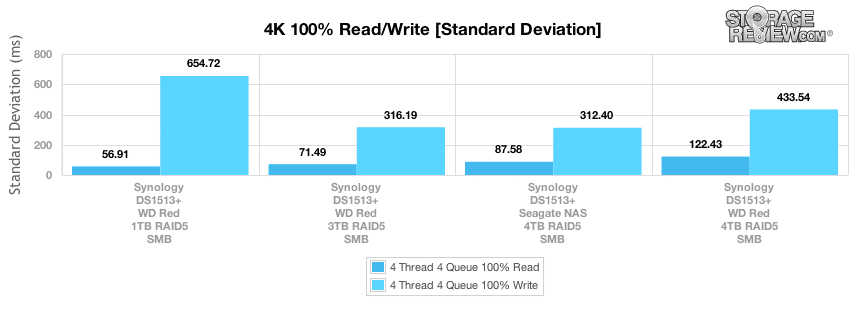
Our next test shifts focus from a pure 4K random read or write scenario to a mixed 8K 70/30 workload. We show how performance scales in this setting from 2T/2Q up to 16T/16Q. When it came down to the drive that offered the best 8K 70/30 throughput, all drives performed very close when configured in RAID5 in our Synology NAS. Comparing first and second generation Red HDDs, the 4TB model did offer some gains over the 3TB version depending on the workload intensity, although those gains did narrow in a few spots. Slotting in between the 3TB and 4TB Red models, the 1TB 2.5″ version proved to be quite capable.
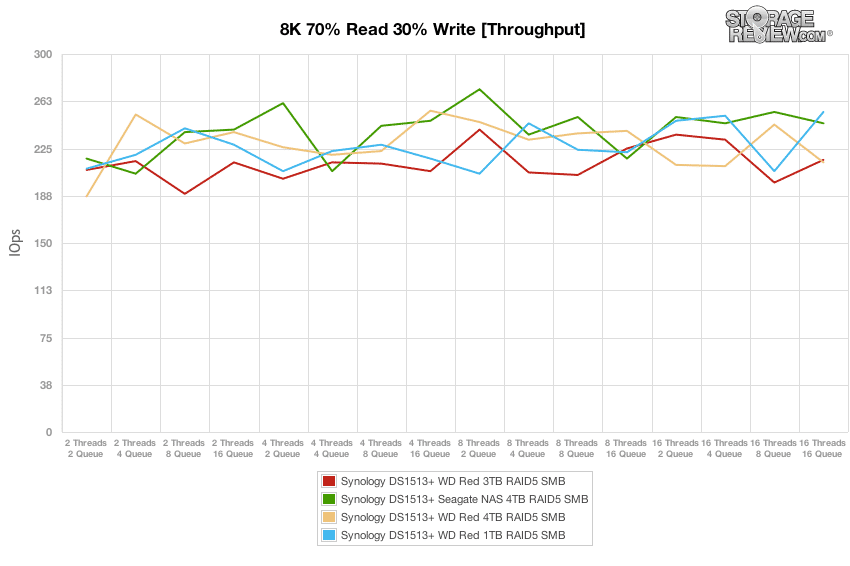
Average latency ranked very close when comparing all the NAS-specific models in our 8K 70/30 test, with the 4TB WD Red and 4TB Seagate NAS both edging towards the front of the group, and the 1TB Red coming in towards the middle.
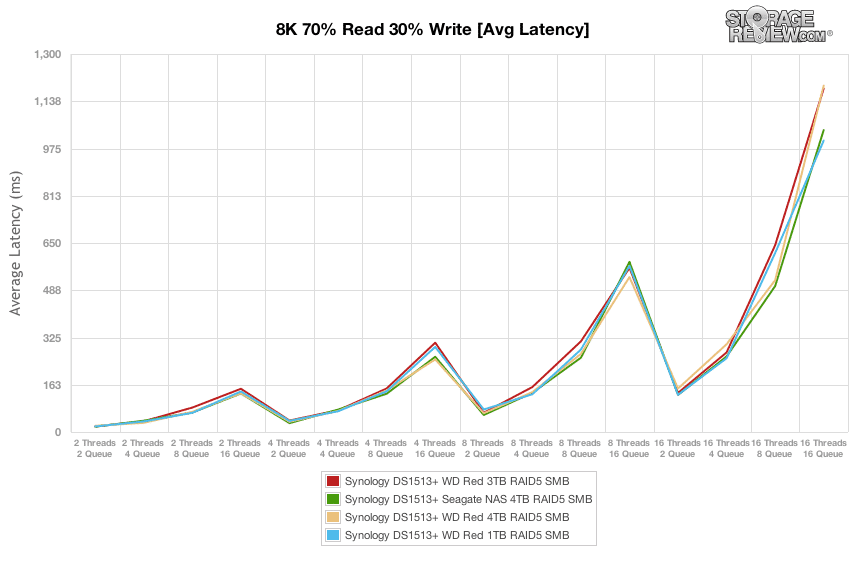
Looking at max latency, there wasn’t really a clear winner in our 8K 70/30 test, with most drives trading positions across our different thread/queue levels.
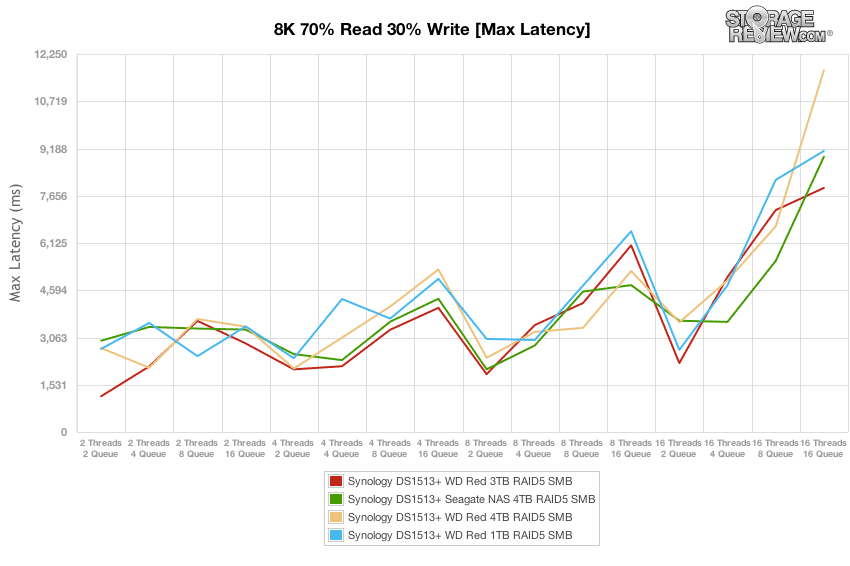
Switching our focus from peak latency to latency consistency in our standard deviation test, the 1TB 2.5″ Red and previous-generation 3TB 3.5″ Red slightly edged out the other models under more stressful conditions.
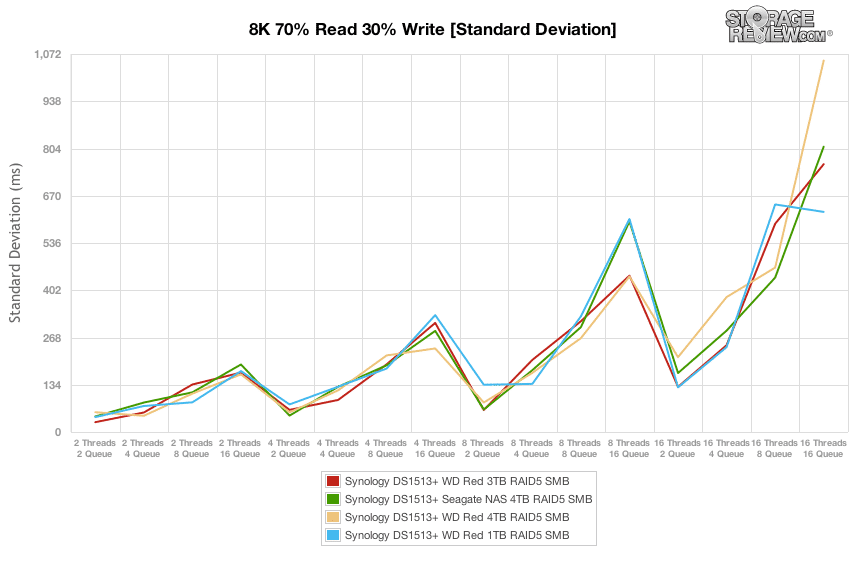
While the first part of the workload comparison measured random workload performance, our second half measures small and large-block sequential transfer speeds. In our first test we measure 8K sequential performance, which we find the 4TB and 1TB WD Red models slipping behind slightly in read performance compared to the 3TB Red, although both offered faster write performance. The leader in this particular test though is the Seagate 4TB NAS that offered both higher read and write throughput.
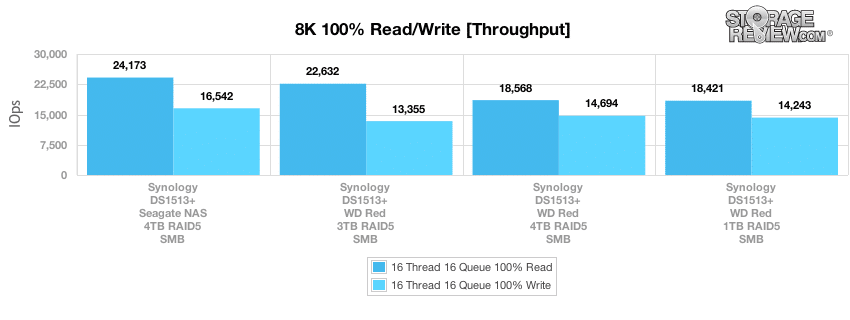
Our last test looks at large-block sequential performance, which both the 1TB and 4TB WD Red lead the group in. The 2.5″ model offered the highest read performance by a slim margin, although when comparing write speed it came in third place. The new 4TB WD Red though came in with the second highest read speed and best-in-class write performance.
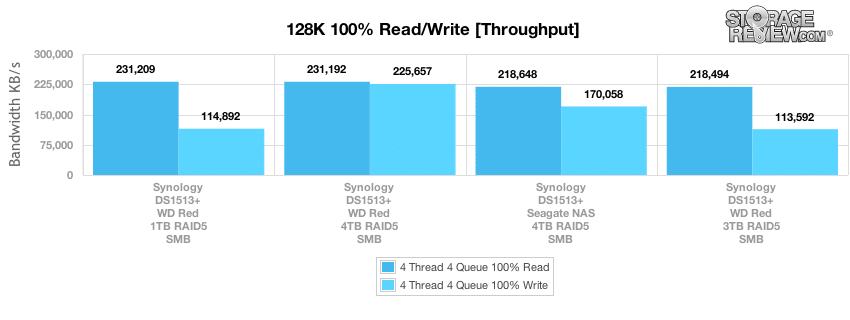
Conclusion
WD Red features several technologies deployed to improve the drive’s suitability for NAS devices. As a result of this effort to tune the drive, Red drives achieve a 35% improvement in mean time between failures when used as part of NAS arrays, according to WD. The 2.5-inch Red drives feature version 2.0 of NASware, WD’s hard drive firmware which reduces noise and power consumption, enables users to monitor performance and reliability via the SMART command set, and provides error recovery tools. WD’s Intellipower low power spindle drops power consumption in drives meant for continuous 24×7 operation in order to reduce cost and heat.
In our tests we found the 1TB 2.5″ WD Red to offer strong performance compared to the WD Slim (5,400RPM) and the HGST 7K1000 (7,200RPM). The 1TB Red offered stronger 4K random performance, although slipped behind the faster-spindle HGST model when it came to sequential transfer speeds. In a 5-drive group installed in a Synology DiskStation DS1513+, we found it to even offer competitive performance against 3.5″ NAS-specific models, with the exception of storage capacity which the other models had a 400% advantage.
The first drives in WD’s Red lineup were 3.5-inch drives, intended to provide a straightforward answer to the question: What is the most suitable drive for use in NAS devices? WD’s new 1TB and 750GB Red drives leverage the technology and market recognition built by the larger Red drives in order to move ahead into the small form factor NAS market. WD is betting that consumers will soon be asking the question: What is the most suitable 2.5-inch drive for NAS devices? The 2.5-inch WD Red drives are in a good position to answer that question and in doing so, establish early leadership for WD in small form factor network storage.
Pros
- First 2.5-inch hard drive tuned for NAS performance
- Performs very well in single-drive tests compared to existing 2.5″ HDD models
- Competitive performance in a multi-drive scenario in our NAS environment
Cons
- Lack of SFF NAS devices in the market
Bottom Line
WD is betting on the emerging market for NAS devices with 2.5-inch drive bays, and has gotten into the market early. If you are looking for a 2.5-inch NAS drive, the WD Red 1TB should definitely be on your radar.
WD Red 2.5″ HDD at Amazon.com



 Amazon
Amazon